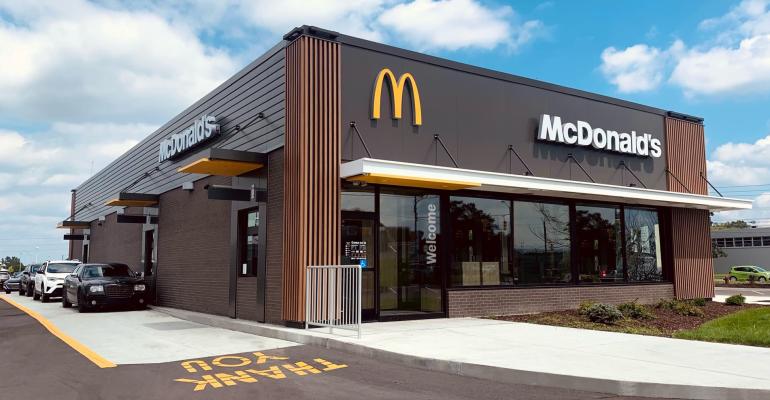term strategies for development, marketing and the menu. But the biggest growth opportunity, at least according to CEO Chris Kempczinski, is on the digital and technology side.
“McDonald’s size and scale gives us competitive advantages that no one else can match. In our rapidly evolving industry, I believe the benefits of scale will become even more pronounced,” he said, calling digital and technology “inherently a scale game.” “McDonald’s scale means we can build capabilities at a pace and cost no one in the industry can match.”
On the customer-facing side, many of those capabilities are centered on the company’s loyalty program, which has become one of the largest in the world, with 150 million 90-day active users. The company expects this loyalty user base to grow to 250 million users in just three years. Those users spend more and visit more, so the company has plenty of incentive to double down on its focus here, including more targeted, personalized offers.
During Investor Day, Joe Erlinger, president of McDonald’s U.S., said this is going to allow the company to “more deeply connect with customers,” adding that mobile is the fastest growing channel with hundreds of millions of mobile orders placed in Q3. In addition to collecting customer data to better personalize offers, McDonald’s is also working to remove friction for mobile orders. Earlier this year, for instance, the company launched “Ready on Arrival,” a geofencing technology that notifies restaurants when customers are approaching and prompts the crew to prepare their orders. Erlinger said the system has driven a 60-second reduction in wait times for customers who pickup via curbside or in restaurant, as well as “significantly higher customer satisfaction scores.”
But there’s more ahead for McDonald’s than just customer-facing tech enhancements. Much more.
As Brian Rice, global chief information officer, explained, the company is currently working to streamline its “fragmented” and “complex” digital experience and move everything to a consistent global platform – loyalty, mobile ordering, kiosks, web, etc.
“While Accelerating the Arches is working, we’re not yet leveraging the full potential of technology or the full potential of scale. Soon, we will,” Rice said. “With a consistent approach, we will be able to deploy innovations with much greater speed and agility.”
To achieve this consistency, McDonald’s is building three new platforms – one for customers, one for restaurants and one for the company.
“Together, they will enable us to execute in a world that is increasingly digital,” Rice said.
The initiative is called “Digitizing the Arches.” Ready on Arrival is a good example of the work being done here. Currently, the system is deployed in the U.S. and will take several months to implement in its top six markets.
“If we had consistency in place today, we would be able to make a single version at the same time,” Rice said.
Another example is the company’s mobile app. Currently, there are different versions of the app in different markets, and they can’t be used effectively across borders.
“In the future, customers will no longer have to download a new app if they’re traveling to a new country,” he said.
And, as part of the Digitizing the Arches strategy, McDonald’s announced a partnership with Google to connect the latest cloud technology and apply generative AI solutions across its global system. This partnership, which Rice said will be the “most sophisticated platform in the industry,” will accelerate automation from equipment manufacturers and allow restaurant managers to quickly spot issues to reduce disruptions.
In other words, it will take the company’s digital efforts behind-the-scenes to better future proof restaurants so they’re equipped to handle constant introductions of new technologies and enable new use cases; for example, developing a new connective restaurant capability that new restaurant equipment can plug in to.
“Think of it as a data highway. It will provide end-to-end visibility on how each of our restaurants are performing. This will unlock cost savings opportunities, improve food quality, enhance customer/crew experiences, and improve restaurant uptime,” Rice said.
And yes, that Google partnership will also expand the chain’s use of generative AI beyond its voice ordering drive-thru system that currently exists at 100 restaurants throughout the U.S. This pilot initially began in 2021 and has since been fine-tuned to create more consistency and reduce operational complexities.
“We believe Gen AI will build structural competitive advantages by leveraging our scale. The more data you feed Gen AI, the better it becomes. With a larger scale, Gen AI is exposed to more diverse information and this diversity allows models to understand a broader range of patterns and nuances, enabling them to make more informed decisions. Our scale, again, gives us a unique advantage,” Rice said.
It's worth noting that robotics are also on the table, should a compelling business case arise, said Manu Steijaert, chief customer officer. All told, Steijaert said adopting operational technologies at scale can “revolutionize” experiences for crew members.
“Managers can get texts based on real-time data from the fryer for preventative maintenance before equipment breaks down,” he said. Or, kitchen systems can automatically optimize product routing based on crew availability. Or, scheduling systems can become fully integrated, to give employees more time to focus on customers versus administrative tasks.
All of this work fits into McDonald’s larger goal to continue digitizing more of its business. Currently, digital sales generate more than 40% of sales across its top six markets, or nearly $9 billion. In China, almost 90% of transactions are digital, providing a solid playbook as to what is possible.
“Some of this may seem years away, but we see what is possible through our teams in China. The future of McDonald’s is always happening somewhere in our system,” Steijaert said. “We just need to find it and scale it.”
Contact Alicia Kelso at [email protected]

